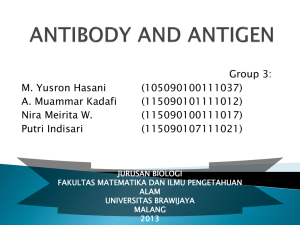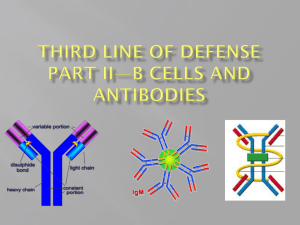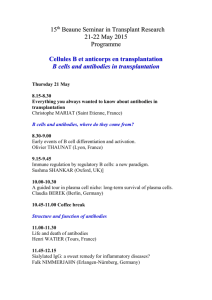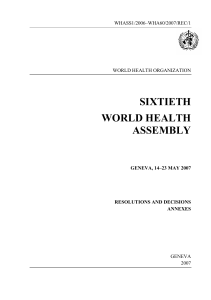Science Journal of Medicine and Clinical Trials Published By ISSN: 2276-7487
advertisement
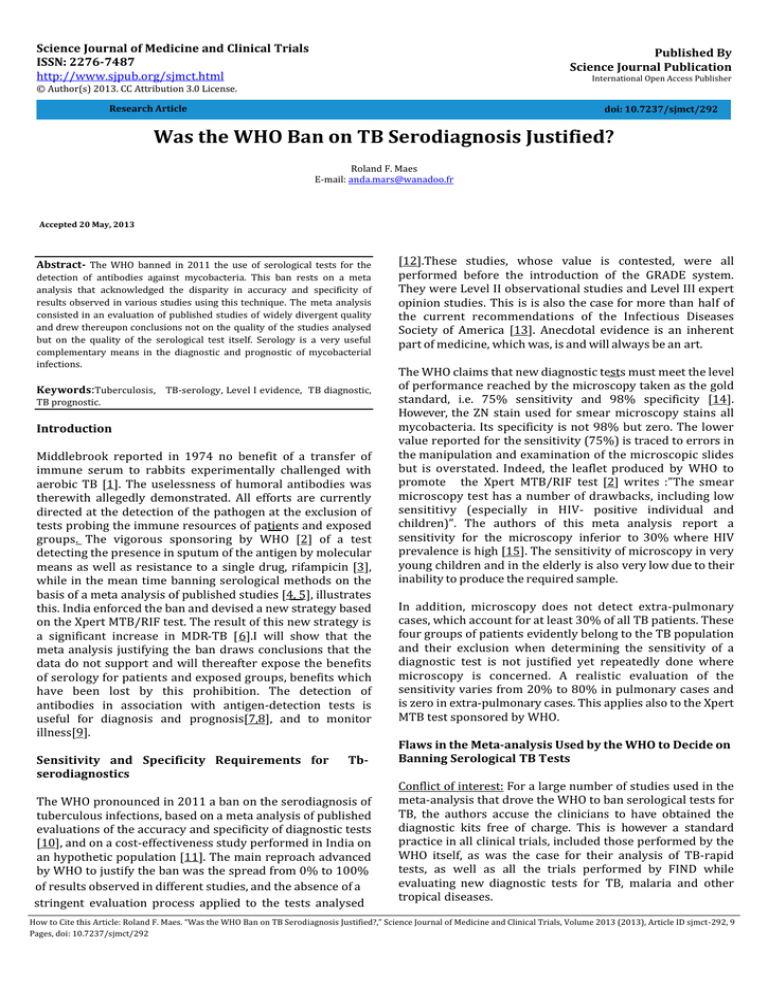
Science Journal of Medicine and Clinical Trials ISSN: 2276-7487 http://www.sjpub.org/sjmct.html Published By Science Journal Publication International Open Access Publisher © Author(s) 2013. CC Attribution 3.0 License. Research Article doi: 10.7237/sjmct/292 Was the WHO Ban on TB Serodiagnosis Justified? Roland F. Maes E-mail: anda.mars@wanadoo.fr Accepted 20 May, 2013 Abstract- The WHO banned in 2011 the use of serological tests for the detection of antibodies against mycobacteria. This ban rests on a meta analysis that acknowledged the disparity in accuracy and specificity of results observed in various studies using this technique. The meta analysis consisted in an evaluation of published studies of widely divergent quality and drew thereupon conclusions not on the quality of the studies analysed but on the quality of the serological test itself. Serology is a very useful complementary means in the diagnostic and prognostic of mycobacterial infections. Keywords:Tuberculosis, TB-serology, Level I evidence, TB diagnostic, TB prognostic. Introduction Middlebrook reported in 1974 no benefit of a transfer of immune serum to rabbits experimentally challenged with aerobic TB [1]. The uselessness of humoral antibodies was therewith allegedly demonstrated. All efforts are currently directed at the detection of the pathogen at the exclusion of tests probing the immune resources of patients and exposed groups. The vigorous sponsoring by WHO [2] of a test detecting the presence in sputum of the antigen by molecular means as well as resistance to a single drug, rifampicin [3], while in the mean time banning serological methods on the basis of a meta analysis of published studies [4, 5], illustrates this. India enforced the ban and devised a new strategy based on the Xpert MTB/RIF test. The result of this new strategy is a significant increase in MDR‐TB [6].I will show that the meta analysis justifying the ban draws conclusions that the data do not support and will thereafter expose the benefits of serology for patients and exposed groups, benefits which have been lost by this prohibition. The detection of antibodies in association with antigen-detection tests is useful for diagnosis and prognosis[7,8], and to monitor illness[9]. Sensitivity and Specificity Requirements for serodiagnostics Tb- The WHO pronounced in 2011 a ban on the serodiagnosis of tuberculous infections, based on a meta analysis of published evaluations of the accuracy and specificity of diagnostic tests [10], and on a cost-effectiveness study performed in India on an hypothetic population [11]. The main reproach advanced by WHO to justify the ban was the spread from 0% to 100% of results observed in different studies, and the absence of a stringent evaluation process applied to the tests analysed [12].These studies, whose value is contested, were all performed before the introduction of the GRADE system. They were Level II observational studies and Level III expert opinion studies. This is is also the case for more than half of the current recommendations of the Infectious Diseases Society of America [13]. Anecdotal evidence is an inherent part of medicine, which was, is and will always be an art. The WHO claims that new diagnostic tests must meet the level of performance reached by the microscopy taken as the gold standard, i.e. 75% sensitivity and 98% specificity [14]. However, the ZN stain used for smear microscopy stains all mycobacteria. Its specificity is not 98% but zero. The lower value reported for the sensitivity (75%) is traced to errors in the manipulation and examination of the microscopic slides but is overstated. Indeed, the leaflet produced by WHO to promote the Xpert MTB/RIF test [2] writes :”The smear microscopy test has a number of drawbacks, including low sensititivy (especially in HIV- positive individual and children)”. The authors of this meta analysis report a sensitivity for the microscopy inferior to 30% where HIV prevalence is high [15]. The sensitivity of microscopy in very young children and in the elderly is also very low due to their inability to produce the required sample. In addition, microscopy does not detect extra-pulmonary cases, which account for at least 30% of all TB patients. These four groups of patients evidently belong to the TB population and their exclusion when determining the sensitivity of a diagnostic test is not justified yet repeatedly done where microscopy is concerned. A realistic evaluation of the sensitivity varies from 20% to 80% in pulmonary cases and is zero in extra-pulmonary cases. This applies also to the Xpert MTB test sponsored by WHO. Flaws in the Meta-analysis Used by the WHO to Decide on Banning Serological TB Tests Conflict of interest: For a large number of studies used in the meta-analysis that drove the WHO to ban serological tests for TB, the authors accuse the clinicians to have obtained the diagnostic kits free of charge. This is however a standard practice in all clinical trials, included those performed by the WHO itself, as was the case for their analysis of TB-rapid tests, as well as all the trials performed by FIND while evaluating new diagnostic tests for TB, malaria and other tropical diseases. How to Cite this Article: Roland F. Maes. “Was the WHO Ban on TB Serodiagnosis Justified?,” Science Journal of Medicine and Clinical Trials, Volume 2013 (2013), Article ID sjmct-292, 9 Pages, doi: 10.7237/sjmct/292 Page 2 The critical question is: did the manufacturer control the publication of the results? The manufacturer of the Anda-TB tests never interfered. No report of bad results: WHO claims that the accuracy of investigated tests is even lower than reported because bad results would not have been published. This assumption is proven false by the meta-analysis itself, which included many “negative” publications. The authors of the meta-analysis present an assumption that does not take into account two facts: 1) publications on clinical trials differ from those reporting fundamental science in that negative results are just as important as positive ones and 2) the drive for investigators to publish is stronger than any pressure can exert to prevent it. Bias in studies analysed: The authors of the meta analysis claim to have accurately reported the results of the trials they included in their meta-analysis. This is not true on several occasions. For example, results concerning pulmonary cases, obtained in Gevaudan’s study [16], were not mentioned in the meta analysis and only extra-pulmonary cases were considered, but no difference was drawn between IgG and IgM antibodies for the evaluation of the results, which confused the outcome. Similarly, the results obtained with pulmonary cases by Alifano[17] are included in the metaanalysis, but not those reported in the same paper and a subsequent paper[18] on extra pulmonary cases. Studies in India: The meta analysis disregards a large number of published studies performed in India. The Indian mycobacterial community is principally concerned with diagnosis of extra-pulmonary and paediatric tuberculosis, and the usefulness of different capture antigens in serodiagnosis. The meta analysis ignored their 46 publications [19]. Evaluation of IgG, IgM and IgA responses: The meta-analysis made no difference between IgG, IgM and IgA antibodies, despite the well-known fact that they have their separate use in diagnosis, as is the case in other diseases such as Mononucleosis and Dengue. IgM detection would be used to detect primary disease in children and adults; that the trials report a low percentage of IgM positive cases only indicates, as is the case with other diseases, that most patients suffer from secondary infections. IgG would be used to confirm secondary or long-standing disease. Detection of IgA has a particular use in TB, as this class of antibodies can still be detected in most cases of immuno-suppression. To lump the results of the IgG, IgM and IgA tests together is illicit. Children: The WHO policy statement claims that no tests were made on infants and children although 7 authors published on this subject [20- 26]. HIV: The policy statement of WHO claims that only one test (SDHO rapid test) was made on HIV populations. I report here three studies on the subject [27- 29]. Latent infections: The study m a d e b y A n d e r s o n [²29] and referenced as # 5 in the indicting meta analysis, announces a 50% sensitivity for the Anda-TB test in HIVpatients. This study focused on the identification of latent infections. W i t h i n t h i s s t u d y , Anderson based his judgment on the value of the serological test on Science Journal of Medicine and Clinical Trials (ISSN: 2276-7487) references #3 and #24. He reported for the Anda Biologicals TB ELISA a positivity rate of 30.8%, which was asserted to be about 10 times higher than the expected conversion rate (3% to 5%) from latent TB infection to active TB infection rates. The reference #3 used by Anderson to claim such a low conversion rate is the guidelines of the American Thoracic Society [30]. These guidelines accept the 4.7% conversion rate found in a study on UK school children [31]. This sample is not representative of populations living in regions of high TB incidence. Reference #24 c i t e d by Anderson upgrades this evaluation to at least 20% [32]. Anderson disregarded this evaluation. This last evaluation (20% or more of reactivation risk) reflects more accurately the true level of the conversion rate in a general population in regions with a high TB incidence. The Anda-tb test appears as an excellent test to detect latent infections. This was already clear from the study of Wirrman [41]. Value of the Cost/effectiveness Analysis The evaluation of the cost of ELISA TB tests made in the publication used by WHO to determine its policy is based on the analysis of a hypothetical Indian population [11]. It states: “Since anda-TB is likely to outperform more poorly studied in-house serological tests and less accurate rapid test formats, and laboratory accuracy is likely to exceed that in the field, our analysis likely overestimates the accuracy of serology”. The 3 assumptions “likely” included in this single sentence applied to a virtual population invalidate the conclusions of the cost analysis. Our inquiries indicate that the prices for a serological test Anda in Delhi and Mumbai vary from 7 to 12 $. The price per test of a Xpert MTB/RIF Test is 14 $, with a huge price reduction of 79%! This reduction will sooner or later be waived. The WHO announces that the cost of testing all MDR-TB and HIVcases by the Xpert Test is 2% of current funding, restricted of course solely to sputum-positive cases [2]. An expose of some situations in which a serological determination is advisable is given infra. The inclusion of a serodiagnostic test that has the properties here mentioned seems reasonable. The ANDA TB Elisa Test The Anda-ELISA tests for TB antibody detection are useful for diagnostic, prognostic and latent infections. 1. The Capture Antigen Complex: A60 A60 is the Thermostable Macromolecular Antigen (TMA) of M. bovis and M. tuberculosis. It is named according to a reference system based on bidimensional immuno electrophoresis. Eighty-nine precipitinogen lines were described for M. bovis BCG and M. tuberculosis [33], of which the line 60t was chosen as capture antigen [34]. The A60 of BCG and that of M. tuberculosis are identical, hence the same name. TMAs are present in all Mycobacteria, Nocardia, and Corynebacteria. A60 is the major proteinic constituent of old tuberculin and is also present in purified protein derivatives (PPD)[35, 36 ]. A60 is the first component against which antibodies are formed in the rabbit [37]. In mice, A60 induces an important primary response followed by a sharp and long‐lastin g secondary response upon boosting [38]. The composition of this How to Cite this Article: Roland F. Maes. “Was the WHO Ban on TB Serodiagnosis Justified?,” Science Journal of Medicine and Clinical Trials, Volume 2013 (2013), Article ID sjmct-292, 9 Pages, doi: 10.7237/sjmct/292 Page 3 antigen, its localisation on the outer membrane of the bacteria, its high antigenic characteristics, its thermostability, make it a first choice antigen for general use in serological tests. 2. A60 Antibodies in Normal Populations, Nontuberculous Patients and Groups at Risk. It has been shown that 4% of the general population in low TB incidence countries has low but significant levels of antiA60 antibodies [39]. These 4% were found to be restricted to two groups of persons, HIV-seropositive groups and drug addicts, both of which are high exposure groups [40]. It has been shown that, within a group of workers, 50% of healthy persons in contact with the general population (i.e. cashiers in a supermarket) and therefore at higher risk of exposure, had IgG anti-TB titres whereas those people employed in administrative tasks and shielded from public contact had none [41]. Further, the positive cases detected among non-tuberculous patients (table 1) are not false but true because not distributed at random. Kaustova confirmed this observation by analysing cancer patients: A60 IgG seropositivity was restricted to only some cancer forms [8] and follow up of patients indicated that seropositivity was indicative of true mycobacterial disease unapparent upon first evaluation. Mycobacterial infections, not necessarily TB, are also frequent in HIV-positives [42], cancerous children [43] and transplant patients [44]. 3. Production of Antibodies in Tuberculous Patients . Figure 1 represents the production of IgG antibodies by four patients under treatment [9]. One patient was devoid of antibodies at entry and failed to produce significant amounts of IgG antibody during treatment but the treatment eliminated the pathogen (negative cultures). The second patient had a low level of antibodies at the start of the treatment, and the treatment timidly amplified their production. A third patient had a high level of antibodies at entry and amplified this response during treatment. The fourth patient had low levels of antibody at entry. This level did not augment during the first three months of treatment, nor did the treatment improve his condition. The clinician modified the regimen on the third month, with a spectacular surge of antibodies and recovery. Figure 2 shows IgG, IgM and IgA production during treatment of one patient during 12.5 months. Only IgM antibodies were detectable at entry. The treatment spurred the synthesis of IgA and IgM antibodies but not of IgG antibodies. This might also have been the case for patients’ output in figure 1. Figure 3 describes the poor production of IgG and IgM antibodies by a patient, which did not increase during treatment, and of IgA antibodies, that were absent throughout. Figure 4 follows a patient for IgG, IgM and IgA antibodies during first treatment and treatment during relapse. No antibody of any class was detected at the beginning of the first treatment but all three increased significantly as soon as treatment started, and declined to base level with recovery. No sign of immunological booster effect could be observed on either IgG or IgA antibody production during the secondary infection, but well an unexpected production of IgM Science Journal of Medicine and Clinical Trials (ISSN: 2276-7487) antibodies, as if the patient was without immunological memory. TB antibodies’ production in patients is personalised, sometimes associated to an immuno-depression affecting in a different way all three classes of antibodies, and its value cannot be assessed with a statistical approach build on linear decreases. 4. Serological Response to a BCG Vaccination. Non-BCG vaccinated infants less than 2 years old were compared to BCG-vaccinated infants less and older than five years for IgG antibodies’ production against A60 (figure 5). No production of antibodies is detected in the non-vaccinated group but antibodies in the two vaccinated groups are also absent, with respectively two and one case barely emerging above the cut-off line. These borderline-positive cases may be traced to increased exposure of the children to contacts outside the home (i.e. nursery, kindergarten and relatives). The absence of IgG antibodies against antigen 60 during the 5 years that followed the vaccination is remarkable since A60 is the dominant antigen during experimental infections [37, 38]. This study, which demonstrates the poor production of IgG antibodies after vaccination of children was completed (figure 6) with the follow-up during three years of infants vaccinated with BCG at birth [21], monitored for the production of IgG and IgM antibodies against PPD and A60. PPD contains A60 antigen but also an array of other molecules [45]. There was virtually no production of IgG antibodies against either A60 or PPD during the first 15 months following vaccination. This observation confirms the data displayed on figure 5. However, antibodies against A60 IgG were detected at birth in the serum of about 50% of the infants and vanished on the second month following the vaccination, indicating a maternal transfer of IgG antibodies against A60 to newborns. IgM antibodies against A60 and PPD were absent at birth and slowly rose in time, with a surge of IgM antibodies against tuberculin at month 24, but not against A60, indicating that these IgM antibodies were directed against the non-peptide moiety of the tuberculin. It is tempting to attribute, at least in part, the variability of efficacy of protection given by the BCG to the presence of IgG maternal antibodies in about 50% of the infants at birth. The late surge of IgM antibodies against PPD remains obscure. Conclusions Reduction of the TB diagnostic problem to antigen detection contributes to the current failure to eradicate this disease. Serological monitoring can help improve the fight against the disease [46- 50] by the following observations: 1. The humoral immune response to TB is just as important as the cellular one, and is subject to partial to total suppression by the pathogen: the depression may independently influence production of IgG, IgM, or IgA anti-TB antibodies in different patients. A heavy bacterial load may correspond to a negative serology. How to Cite this Article: Roland F. Maes. “Was the WHO Ban on TB Serodiagnosis Justified?,” Science Journal of Medicine and Clinical Trials, Volume 2013 (2013), Article ID sjmct-292, 9 Pages, doi: 10.7237/sjmct/292 Page 4 2. 3. One third of humanity is infected by a mycobacterial entity but most mycobacterial infections are latent, indicating that TB is an inefficient pathogen needing particular conditions to develop disease. Antibody detection is a good means to discover the cases prone to convert. Mycobacterial infections revealed by the presence of antibodies are observed with variable frequency in non –tuberculous patients suffering from diverse diseases. Not all diseases allow a mycobacterial-superposed infection. 4. An immunosuppressive drug may demonstrate an anti-TB activity in vitro but its immunosuppressive activity will remain concealed. In patients, the immunosuppression of the drug will add to the immunosupression induced by TB. 5. BCG rarely elicits IgG antibodies against the mycobacterial dominant A60-antigen in vaccinated newborns. Transferred maternal IgG antibodies may impair the efficacy of the vaccination. 6. Primary TB: serology of the IgM and IgG classes is a good adjunct to a microscopy that may be wanting. 7. Secondary TB: serology is useful in paucibacillary and extra-pulmonary TB. 8. Serology is advisable in children who yield poor sputum samples and are mostly paucibacillary. 9. The elderly produce sputum with difficulty, which makes serology useful. 10. Serology is very useful for prognosis and patient followup during treatment. Contrary to the conclusions of the meta-analysis and of the cost-effectiveness studies, serological tests based on A60 have their use and are not as expensive as claimed. At least in the field of diagnosis, we have serological tools that complement the standard ones and that are even more efficient than them in some groups of people. As other diagnostic tools, the serology has strengths and weaknesses. Its use not only allows to detect a large number of TB patients negative with the conventional methods but it also allows to uncover hitherto unsuspected aspects of the tuberculosis problem. References 1. 2. 3. Reggiardo Z, Middlebrook G. Failure of passive serum transfer of immunity against aerogenic tuberculosis in rabbits. Proc Soc Exp Biol Med 1974;145: 173-5. WHO May 2012. Tuberculosis. Diagnostics Xpert MTB/RIF Test. http.//WHO.int/tb/laboratory. Boehme C, Nocol M, Nabeta P, Michael J, Gotuzzo E, Tahirli R, et al. Feasibility, diagnostic accuracy, and effectiveness of decentralised us of Xpert MTB/RIF test for diagnosis of tuberculosis and multidrug resistance: a multicentre Science Journal of Medicine and Clinical Trials (ISSN: 2276-7487) 4. implementation study. Lancet 2011; 377(9776) : 14951505. 5. 6. 7. 8. 9. WHO TDR: Commercial serodiagnostic tests for diagnosis of tuberculosis expert group meeting report. 22 July 2010. WHO: Commercial serodiagnostic tests for diagnosis of tuberculosis. Policy Statement. 2011 (www.who.int). The Wall Street Journal: Global TB fight hits a wall. India’s new strategy actually makes disease more drug resistant, doctors say. February 20, 2013. Cocito C. Properties of mycobacterial antigen complex A60 and its applications to the diagnosis and prognosis of tuberculosis. Chest 1991;100:1687-93. Kaustova J. Serological IgG, IgM and IgA diagnosis and prognosis of mycobacterial diseases in routine practice. Eur J Med Res 1995;1:393-403. Fadda G, Grillo R, Ginesu F, Santoru L, Zanetti S, Dettori G. Serodiagnosis and followup of patients with pulmonary tuberculosis by enzyme-linked immunosorbent assay. Eur J Epidemiol 1992;8(1):81-7. 10. Steingart KR, Flores LL, Dendukuri N, Schiller I, Laal S, Ramsay A. et al. Commercial Serological Tests for the Diagnosis of Active Pulmonary and Extrapulmonary Tuberculosis: An Updated Systematic Review and Meta- Analysis. PLoS Med 2011;8(8):e1001062. Epub 2011 August 9. 11. 12. 13. Dowdy DW, Steingart KR, Pai M. Serological Testing Versus Other Strategies for Diagnosis of Active Tuberculosis in India: A CostEffectiveness Analysis. PLoS Med Epub 2011;8(8):e1001074. Guyatt G, Oxman A, Vist G, Kunz R, Falck-Ytter Y, Alonso- Coello P. et al.: GRADE: an emerging consensus on rating quality of evidence and strength of recommendations. BMJ 2008;336:924-6. Heun Lee D, Vielemeyer O. Analysis of Overall Level of Evidence Behind Infectious Diseases Society of America Practice Guidelines. Arch Intern Med 2011;171(1):18-22. 14. Foulds J, O'Brien R. New tools for the diagnosis of Tuberculosis : the perspective of low income countries. WHO Tuberculosis Diagnostic Workshop. 27 July 1997, Cleveland, OH. 15. 16. 17. 18. Steingart K R, Ramsay A, Pai M. Optimizing sputum smear microscopy for the diagnosis of pulmonary tuberculosis. Rev Anti Infect Ther 2007; 5: 327–331. Gevaudan MJ, Bollet C, Charpin D, Mallet MN, De Micco Ph. Serological response of tuberculosis patients to Antigen 60 of BCG. Eur J Epidemiol 1992;8(5):666-76. Alifano M, Del Pezzo M, Lambertini C, Faraone S, Covelli I. Elisa method for evaluation of anti-A60 IgG in patients with pulmonary and extrapulmonary tuberculosis. Microbiologica 1994;17:37-44. Alifano M, Del Pezzo M, Lambertini C, Faraone S, Covelli I. Detection of IgG and IgA against the mycobacterial antigen A60 in patients with extrapulmonary tuberculosis. Thorax 1998;53:377-80. How to Cite this Article: Roland F. Maes. “Was the WHO Ban on TB Serodiagnosis Justified?,” Science Journal of Medicine and Clinical Trials, Volume 2013 (2013), Article ID sjmct-292, 9 Pages, doi: 10.7237/sjmct/292 Page 5 19. 20. 21. 22. 23. 24. Science Journal of Medicine and Clinical Trials (ISSN: 2276-7487) Association of Diagnostic Manufacturers Of India. Use of serological markers for diagnosis of tuberculosis in India. A review of Indian literature. Eds. ADMI 2012. 34. Cocito C, Vanlinden F. Preparation and properties of antigen 60 from mycobacterium bovis BCG. Clin exp Immunol 1986; 66: 262-72. Rota S, Beyazova U, Karsligil T, Cevheroglu C. Humoral immune response against antigen 60 in BCG vaccinated infants. Eur J Epidemiol 1994;10: 713-8. 36. Delacourt C, et al. Value of ELISA using antigen A60 for the diagnosis of tuberculosis in children. Chest 1993;104: 393-8. Turneer E, et al. Determination of Humoral Immunoglobulins M and G Directed against Mycobacterial Antigen 60 Failed to Diagnose Primary Tuberculosis and Mycobacterial Adenitis in Children. Am J Respir Crit Care Med 1994;150: 1508-12. Singh P, Baveja CP, Talukdar B, Kumar S, Mathur MD. Diagnostic Utility of ELISA Test Using Antigen A60 in Suspected Cases of Tuberculous Meningitis in Paediatric Age Group. Indian J Pathol Microbiol 1999;42(1): 11-4. Swaminathan S, Umadevi P, Shantha S, Radhakrishnan A, Datta M. Sero diagnosis of tuberculosis in children using Two Elisa kits. Indian J Pediatr 1999; 66: 837-42. 25. Khalilzadeh S, Yazdanpanah S. Sero diagnosis of tuberculosis in children using A60 antigens. Int J Tubercul Lung Dis 2001; 5(11):200. 26. 27. Gupta S, Bhatia R, Datta KK. Serological diagnosis of childhood tuberculosis by estimation of mycobacterial antigen A60specific immunoglobulins in the serum. Tubercle Lung Dis 1997 ;78(1): 21-7. van der Werf TS, et al. Sero-diagnosis of tuberculosis with A60 antigen enzyme-linked immunosorbent assay : failure in HIVinfected individuals in Ghana. Med Microbiol Immunol 1992;181: 71-6. 28. Pouthier F et al. Anti-A60 immunoglobulin G in the serodiagnosis of tuberculosis in HIV-seropositive and seronegative patients. AIDS 1994; 8: 1277-80. 29. 30. 31. 32. Anderson BL, Welch RJ, Litwin CM. Assessment of three commercially available serologic assays for detection of antibodies to Mycobacterium tuberculosis and identification of active tuberculosis. Clin Vaccine Immunol 2008;15(11):1644-9. American Thoracic Society. Targeted tuberculin testing and treatment of latent tuberculosis infection. Am J Respir Crit Care Med 2000;161:221–47. Sutherland I. The ten-year incidence of clinical tuberculosis following "conversion" in 2550 individuals aged 14 to 19 years. TSRU Progress Report 1968 ; KNCV, The Hague, Netherlands. Horsburgh C. R. Jr. Priorities for the treatment of latent tuberculosis infection in the United States. N Engl J Med 2004;350:2060–67. 33. Closs O, Harboe M, Axelsen NH, Bunch-Christensen K, Magnusson M. The antigens of mycobacterium bovis strain BCG, studied by crossed immunoelectrophoresis: a reference system. Scand J Immunol 1980;12: 249-63. 35. 37. 38. 39. 40. 41. 42. 43. 44. 45. 46. 47. 48. 49. Cocito C, Benoit Ch, Baelden M-C, Vanlinden F. Properties of the TMA group of mycobacterial antigens and their use for diagnosis of mycobacterial diseases. Quad. Coop. Sanit. - Health Coop. Papers 1988;7:145-52. Fabre I, L'Homme O, Bruneteau M, Michel G, Cocito C. Chemical composition of antigen 60 from Mycobacterium bovis BCG. Scand J Immunol 1986; 24: 591-602. Shana RM, Closs O, Harboe M. Antibodies in rabbits to Mycobacterium bovis BCG. Scand J Immunol 1979; 9: 175-82. Cocito C, Baelden M-C, Benoit Ch. Immunological properties of antigen 60 of BCG: induction of humoral and cellular immune reactions. Scand J Immunol 1987; 25:579-85. Mandler F. et al. Valutazione del valore predittivo del test sierologico in elisa A60 (TB-test) nelle diagnosi clinica di affezioni tubercolari. The Eurospital J. 1991 ; Grado : 5-14. Maes R. Incidence of inapparent active mycobacterial infections in France detected by an IgG serological test based on antigen 60. Med Microbiol Immunol 1989 ;178: 315-21. Wirrmann C. Public health application of a serological test for tuberculosis: study of the incidence of unapparent infections among employees of an Alsatian supermarket. Eur J Epidemiol 1990; 6: 304-8. Del Pezzo M, De Philippis A, D'Alessio A, Rosiello M, Tosone G, Guletta E. A serological study of mycobacterial infections in AIDS and HIV-1 positive patients. J Bacteriol Virol Immunol 1990;83:3-9. Graham J.C. et al. Non-Tuberculous mycobacterial infection in children with cancer. Eur J Clin Microbiol Infect. Dis. 1998; 17: 394-7. Patel R, Roberts GD, Keating MR, Paya CV. Infections due to non tuberculous -mycobacteria in kidney, heart, and liver transplant recipients. Clin Inf Dis 1994; 19: 263-74. Harboe M. Antigens of PPD, Old tuberculin, and autoclaved mycobacterium bovis BCG studied by crossed immunoelectrophoresis. Am Rev Respir Dis 1981; 124: 80-7. Maes H, Causse J.E, Maes RF. Mycobacterial infections: Are the Observed Enigmas and Paradoxes Explained by Immunosuppression and Immunodeficiency? Med Hypotheses 1996; 46:163-71. Maes H, Causse JE, Maes R. Tuberculosis I: a conceptual frame for the immunopathology of the disease. Med Hypotheses 1999;52(6):583-93. Maes R. Clinical usefulness of serological measurements obtained by antigen A60 in mycobacterial infections : development of a new concept. Klin Wochenschr 1991;69:696-709. Maes RF. Tuberculosis II: the failure of the BCG vaccine. Med Hypotheses 1999;3(1): 2-9. How to Cite this Article: Roland F. Maes. “Was the WHO Ban on TB Serodiagnosis Justified?,” Science Journal of Medicine and Clinical Trials, Volume 2013 (2013), Article ID sjmct-292, 9 Pages, doi: 10.7237/sjmct/292 Page 6 Science Journal of Medicine and Clinical Trials (ISSN: 2276-7487) 50. Maes RF. The tuberculosis enigma : need for a new paradigm: importance of a knowledge of the immune status of the patients. Biomedicine 1999; 19(1):1-14. Table 1: Frequency of anti-mycobacterial IgG antibodies in patients suffering from various illnesses. Diseases Viral Infections HIV-Sero-Positives Mycoplasma Toxoplasmosis Amoebiasis Crohn’s Disease Bacterial Pneumopathies Cold Coxiella Syphilis Asthma AIDS Legionella Sarcoidosis Cancer Pneumopathies Echinococcus Cistic Fibreosis Leishmaniasis Norcardia Positives/Total % 0/32 4/143 0/11 0/33 0/10 0/34 1/24 1/46 1/17 0 2.7 0 0 0 3 0 2.2 5 15/33 19/31 5/5 45 62 100 3/31 7/72 12/75 6/18 12/53 26/175 6/20 10 10 16 33 23 15 30 Figure 1: IgG response monitored in four patients during TB treatment. "C" represents positive cultures. How to Cite this Article: Roland F. Maes. “Was the WHO Ban on TB Serodiagnosis Justified?,” Science Journal of Medicine and Clinical Trials, Volume 2013 (2013), Article ID sjmct-292, 9 Pages, doi: 10.7237/sjmct/292 Page 7 Science Journal of Medicine and Clinical Trials (ISSN: 2276-7487) Figure 2: Antibodies of the IgA, IgG and IgM classes produced duing TB treatment. Figure 3: Monitoring of IgA, IgG and IgM classes in a patient under TB treatment. How to Cite this Article: Roland F. Maes. “Was the WHO Ban on TB Serodiagnosis Justified?,” Science Journal of Medicine and Clinical Trials, Volume 2013 (2013), Article ID sjmct-292, 9 Pages, doi: 10.7237/sjmct/292 Page 8 Science Journal of Medicine and Clinical Trials (ISSN: 2276-7487) Figure 4: Production of antibodies of the IgA, IgG and IgM classes in a TB patient who relapsed. Figure 5: Production of IgG antibodies against A60 in non-vaccinated and BCG vaccinated children. How to Cite this Article: Roland F. Maes. “Was the WHO Ban on TB Serodiagnosis Justified?,” Science Journal of Medicine and Clinical Trials, Volume 2013 (2013), Article ID sjmct-292, 9 Pages, doi: 10.7237/sjmct/292 Page 9 Science Journal of Medicine and Clinical Trials (ISSN: 2276-7487) Figure 6: Production of IgG and IgM antibodies against A60 and PPD in BCG-vaccinated children. How to Cite this Article: Roland F. Maes. “Was the WHO Ban on TB Serodiagnosis Justified?,” Science Journal of Medicine and Clinical Trials, Volume 2013 (2013), Article ID sjmct-292, 9 Pages, doi: 10.7237/sjmct/292

